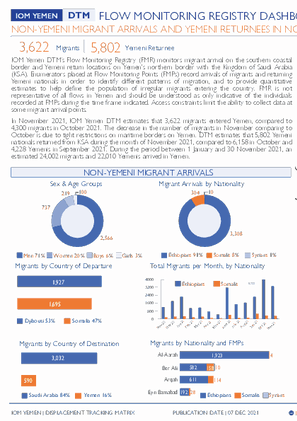-
Countries
-
Data and Analysis
-
Special Focus
-
Crisis Responses
Yemen - Flow Monitoring Points | Non-Yemeni Migrant Arrivals And Yemeni Returnees In November 2021

Contacter
DTM Yemen, iomyemendtm@iom.int
Langue
English
Emplacement
Yemen
Période couverte
Nov 01 2021
Nov 30 2021
Activité
- Flow Monitoring Survey
- Flow Monitoring
IOM Yemen DTM’s Flow Monitoring Registry (FMR) monitors migrant arrival on the southern coastal border and Yemeni return locations on Yemen's northern border with the Kingdom of Saudi Arabia (KSA). Enumerators placed at Flow Monitoring Points (FMPs) record arrivals of migrants and returning Yemeni nationals in order to identify different patterns of migration, and to provide quantitative estimates to help define the population of irregular migrants entering the country. FMR is not representative of all flows in Yemen and should be understood as only indicative of the individuals recorded at FMPs during the time frame indicated. Access constraints limit the ability to collect data at some migrant arrival points.
In November 2021, IOM Yemen DTM estimates that 3,622 migrants entered Yemen, compared to 4,300 migrants in October 2021. The decrease in the number of migrants in November comparing to October is due to the stable security situation in Ethiopia, as well as the increase in military restrictions on maritime borders from the government side in Yemen and Djibouti. DTM estimates that 5,802 Yemeni returns from KSA during the month of November 2021, compared to 6,158 in October and 4,228 Yemenis in September 2021. During the period between 1 January and 30 November 2021, an estimated 24,002 migrants and 22,010 Yemenis arrived in Yemen.
The migrant caseload was 91 per cent Ethiopian, eight per cent Somali, and one per cent Syrian. The migrants are predominantly male (71%), with (20%) women, six per cent boys and three per cent girls also among the travelers.
Through November reporting period, 1,695 migrants arrived from Somalia and were recorded 750 at Ber Ali, 725 at Arqah, and 220 at Eyn Bamabad flow monitoring points in Shabwah and Hadramout governorates. Al Aarah flow monitoring point in Lahj governorate saw the highest number of migrant arrivals, with 1,927 migrants arriving from Djibouti.
METHODOLOGY:
DTM’s global flow monitoring methodology aims to identify areas prone to internal, cross-border and regional migration. Mobility area assessments are conducted at the national level. DTM teams then collect information at the local level to identify key transit points. Enumerators collect data from key informants at the flow monitoring points: key informants may be transport staff, custom officers, boat operators or migrants themselves. Data is collected through a basic form combined with direct observations –enabling breakdowns.
LIMITATIONS:
Data collected for these exercises should be understood as estimations only. They represent only part of the total flows passing through Yemen. The spatial and temporal coverage of this data collection activity is therefore incomplete. In addition, although data is collected daily, it is collected only during peak hours. The portion of the flows that occur during the uncovered hours is not represented. Data on vulnerability is based on direct observation and should be understood as mainly indicative.
